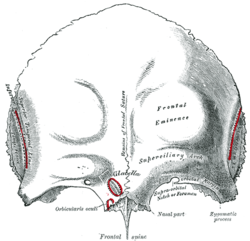Squamous part of the frontal bone
| Squamous part of the frontal bone | |
|---|---|
 Frontal bone.Outer surface. (The squamous part is the upper two thirds.) | |
 Frontal bone. Inner surface. (The squamous part is the upper two thirds.) | |
| Details | |
| Identifiers | |
| Latin | squama frontalis |
| TA98 | A02.1.03.002 |
| TA2 | 521 |
| FMA | 52848 |
| Anatomical terms of bone | |
Thesquamous part of the frontal boneis the superior (approximately two thirds) portion when viewed in standard anatomical orientation. There are two surfaces of the squamous part of thefrontal bone:the external surface, and the internal surface.
External surface
[edit]
Theexternal surfaceis convex and usually exhibits, in the lower part of the middle line, the remains of thefrontal suture;in infancy this suture divides the frontal bone into two and later fuses. A condition where fusion has not taken place, may persist throughout life and is referred to as ametopic suture.
On either side of this suture, about 3 cm. above the supraorbital margin, is a rounded elevation, thefrontal eminence(tuber frontale).
These eminences vary in size in different individuals, are occasionally unsymmetrical, and are especially prominent in young skulls; the surface of the bone above them is smooth, and covered by theepicranial aponeurosis.
Below the frontal eminences, and separated from them by a shallow groove, are two arched elevations, thesuperciliary arches;these are prominentmedially,and are joined to one another by a smooth elevation named theglabella.They are larger in the male than in the female, and their degree of prominence depends to some extent on the size of thefrontal air sinuses;prominent ridges are, however, occasionally associated with small air sinuses.
Beneath each superciliary arch is a curved and prominent margin, thesupraorbital margin,which forms the upper boundary of the base of theorbit,and separates the squamous part from the orbital portion of the bone.
The lateral part of this margin is sharp and prominent, affording to the eye, in that situation, considerable protection from injury; the medial part is rounded.
At the junction of its medial and intermediate thirds is a notch, sometimes converted into aforamen,thesupraorbital notchor foramen, which transmits the supraorbital vessels and nerve.
A small aperture in the upper part of the notch transmits a vein from thediploëto join thesupraorbital vein.
The supraorbital margin ends laterally in thezygomatic process,which is strong and prominent, and articulates with thezygomatic bone.
Running upward and backward from this process is a well-marked line, thetemporal line,which divides into the upper and lower temporal lines, continuous, in the articulated skull, with the corresponding lines on the parietal bone.
The area below and behind the temporal line forms the anterior part of thetemporal fossa,and gives origin to thetemporalis muscle.
Between the supraorbital margins the squamous part projects downward to a level below that of the zygomatic processes. It meets thenasal bonewhere it presents a rough, uneven serrated notch known as thenasal notch,and this articulates on either side of the middle line with the nasal bone, and laterally with thefrontal process of the maxillaand with thelacrimal.This part is sometimes called thenasal part of frontal bone.
The termnasionis applied to the middle of thefrontonasal suture.From the center of the notch the nasal process projects downward and forward beneath the nasal bones and frontal processes of themaxillae,and supports the bridge of the nose.
The nasal process ends below in a sharp spine, and on either side of this is a small grooved surface which enters into the formation of the roof of the corresponding nasal cavity.
The spine forms part of theseptumof the nose, articulating in front with the crest of the nasal bones and behind with the perpendicular plate of theethmoid.
Internal surface
[edit]Theinternal surfaceof the squamous part is concave and presents in the upper part of the middle line a vertical groove, thesagittal sulcus,the edges of which unite below to form a ridge, the frontal crest; thesulcuslodges the superior sagittal sinus, while its margins and the crest afford attachment to thefalx cerebri.
The crest ends below in a small notch which is converted into a foramen, theforamen cecum,by articulation with theethmoid.
This foramen varies in size in different subjects, and is frequently impervious; when open, it transmits a vein from the nose to thesuperior sagittal sinus.
On either side of the middle line the bone presents depressions for the convolutions of the brain, and numerous small furrows for the anterior branches of the middle meningeal vessels.
Several small, irregular fossae may also be seen on either side of thesagittal sulcus,for the reception of thearachnoid granulations.
References
[edit]![]() This article incorporates text in thepublic domainfrompage 135of the 20th edition ofGray's Anatomy(1918)
This article incorporates text in thepublic domainfrompage 135of the 20th edition ofGray's Anatomy(1918)
External links
[edit]- "Anatomy diagram: 34256.000-1".Roche Lexicon - illustrated navigator.Elsevier. Archived fromthe originalon 2012-12-27.
